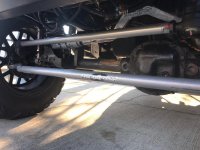Yep. Finally getting the first run started tomorrow.
I used to be all about the DOM, but now I’m manufacturing them out of 1.5” 7075 aluminum. Which is better? Well it all comes down to money. If you’re on a budget and can DIY the tie rod, then the RuffStuff kit is a no brainer. It’s relatively cheap and if done right can be a damn nice, strong tie rod. Some people claim they bend easy but I’ve never had any of the ones I’ve built and install have any issues. However, they are heavy and I ALWAYS tig welded the bungs in which is time consuming. 3 passes on a good size bevel takes time. Also, due to the weight they are more costly to shop.
Sent from my iPhone using
WAYALIFE mobile app


